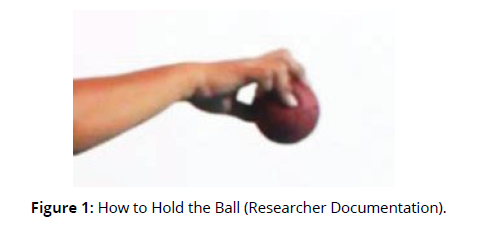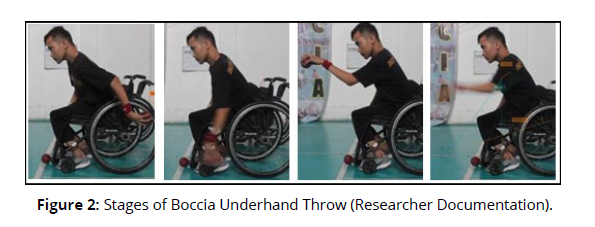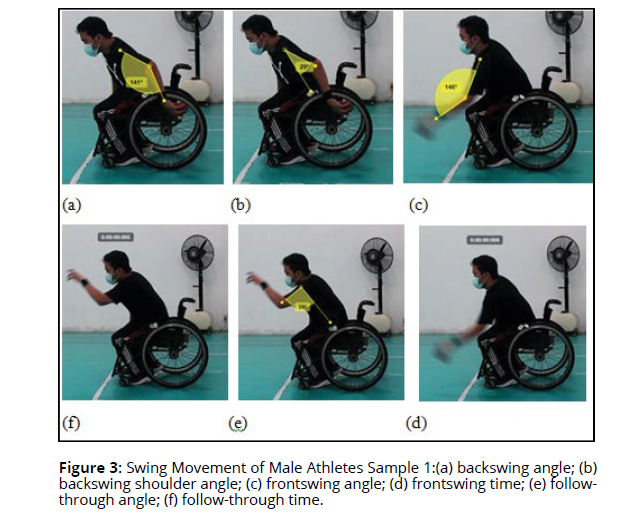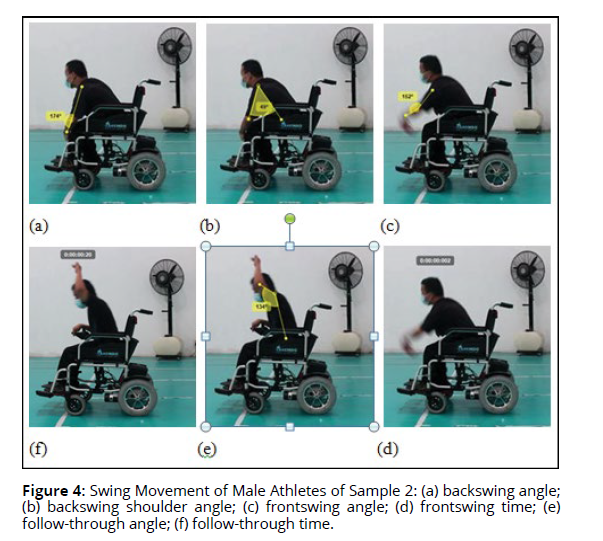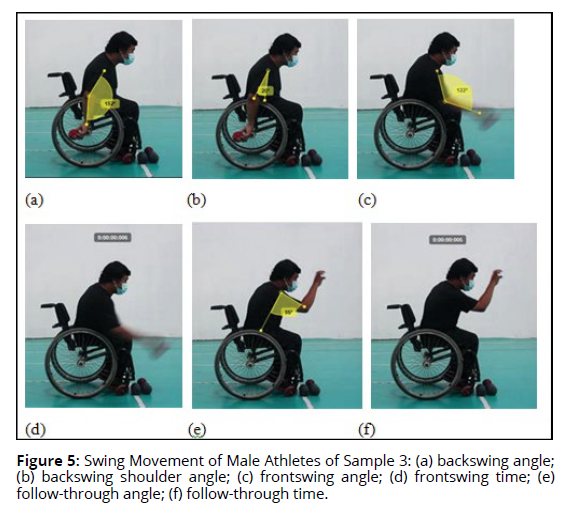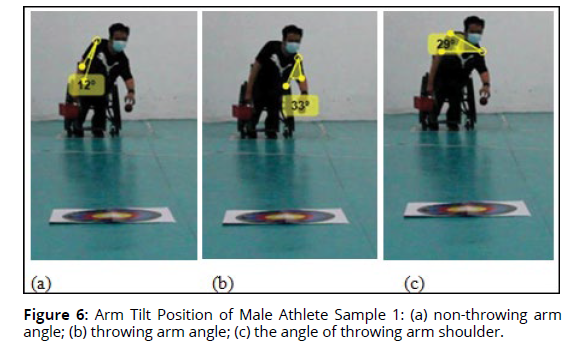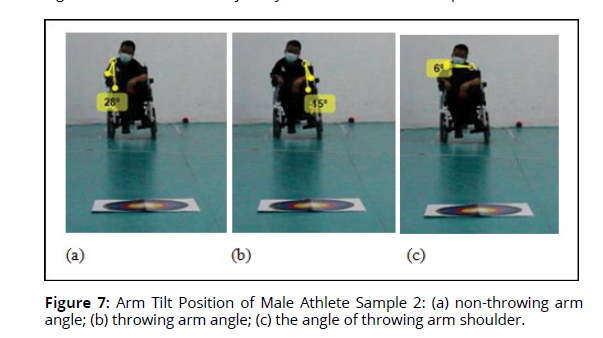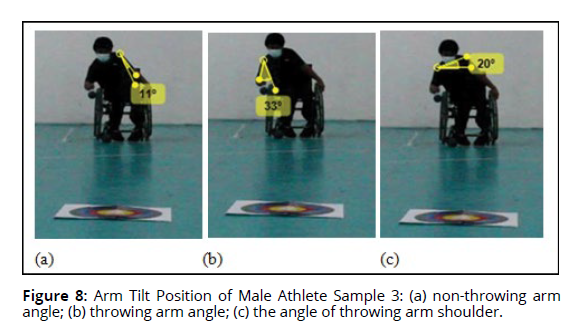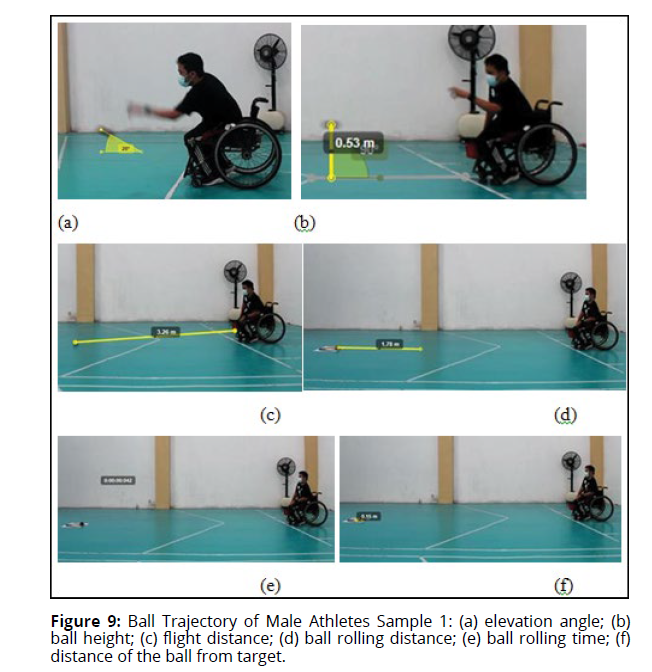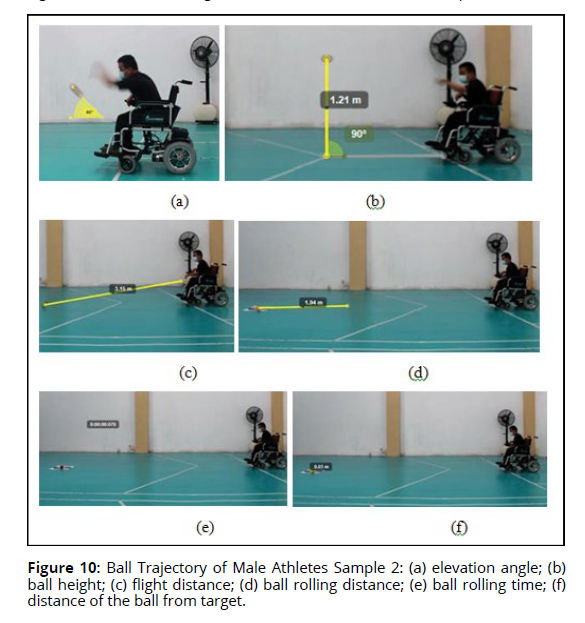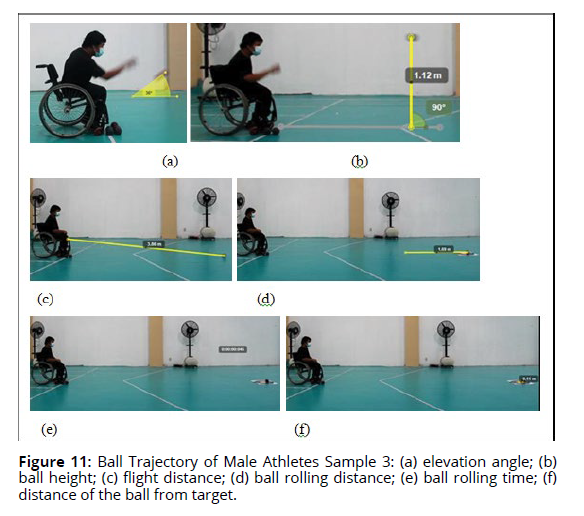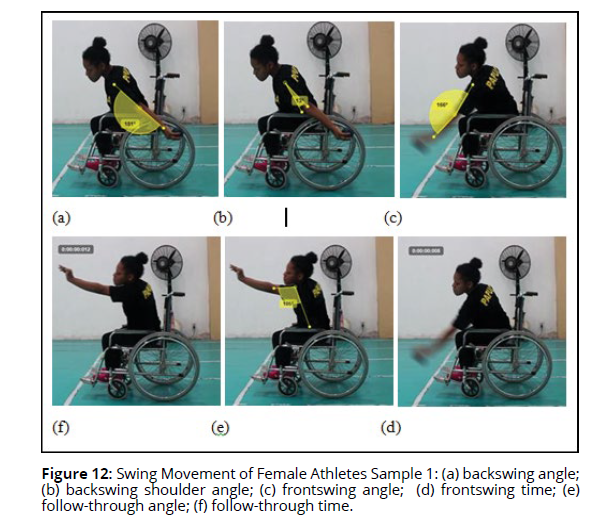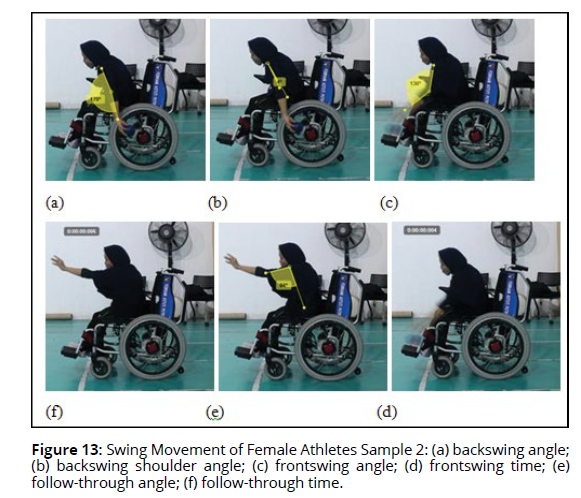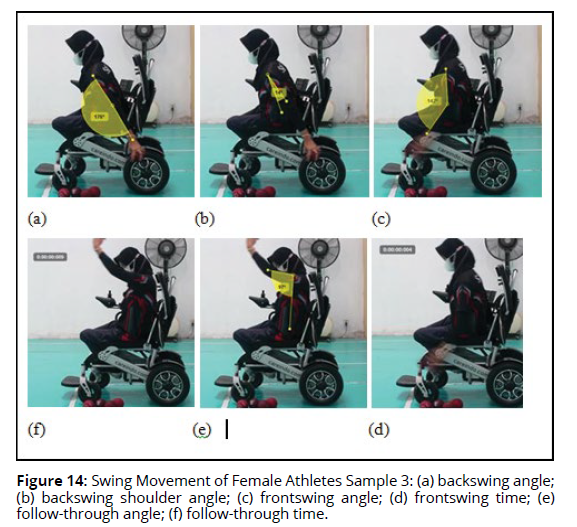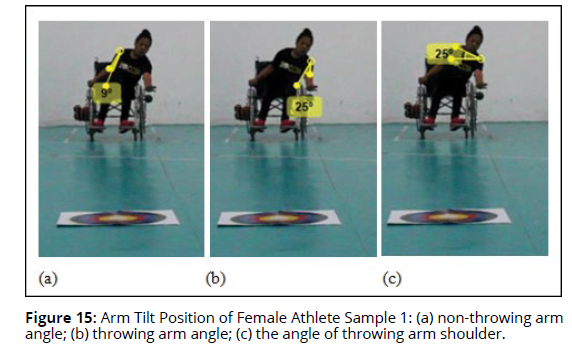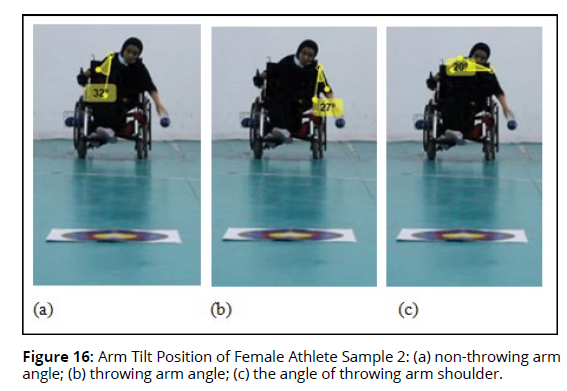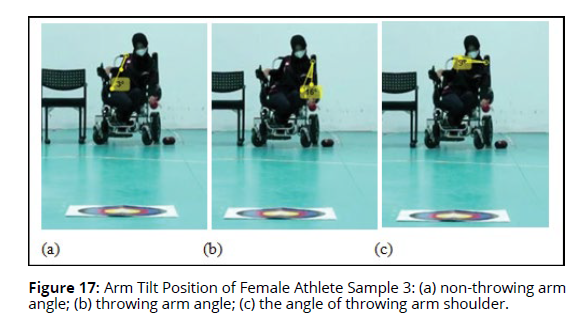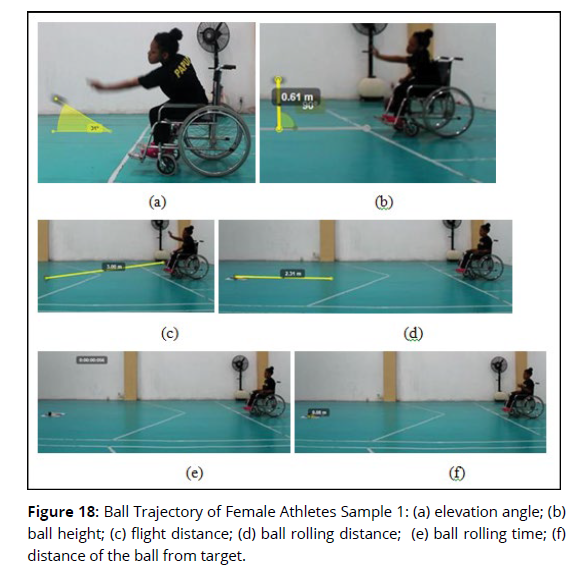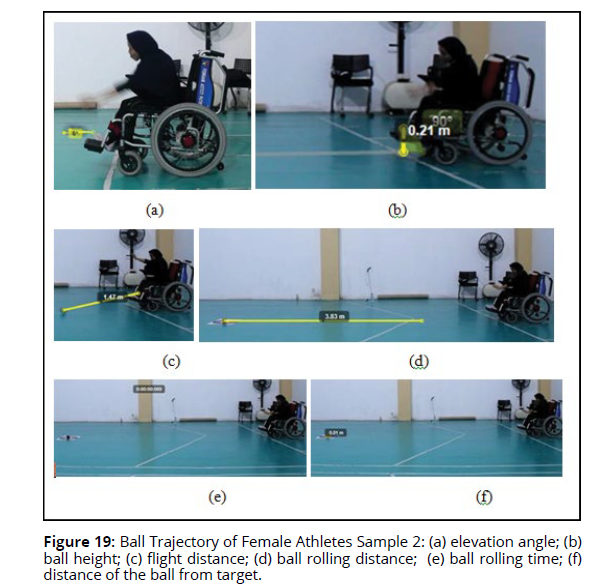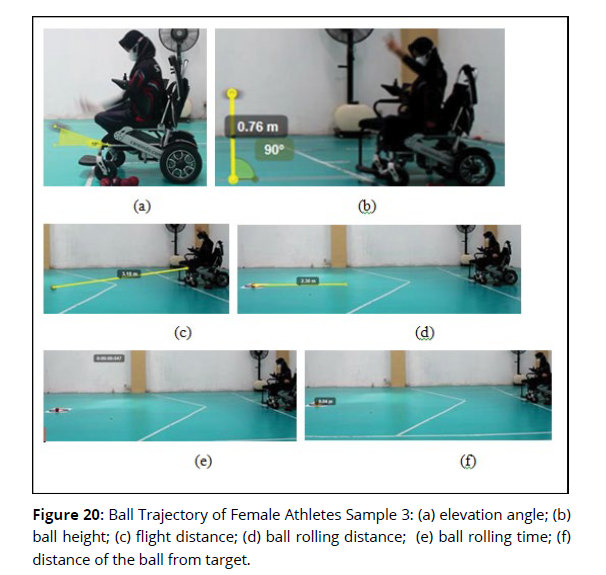Full Length Research Article - (2023) Volume 18, Issue 2
Gender Differences In Boccia Underhand Throw Biomechanics
Singgih Hendarto*, Rumi Iqbal Doewes, Satria Yudi Gontara and Manshuralhudlori*Correspondence: Singgih Hendarto, Faculty of Sport, Universitas Sebelas Maret, Jl. Ir. Sutami, 36A, Kentingan, Surakarta, Indonesia, Email:
Received: 08-Mar-2023 Accepted: 22-Mar-2023 Published: 22-Mar-2023
Abstract
The study purpose was determined gender differences in the boccia underhand throw biomechanics. The research method was used a cross sectional study. The 6 boccia athletes were sampled consisting of 3 male and 3 female. The research instrument was used a throw accuracy test. Movement analysis was recorded using a camera placed on the side of the throwing arm and associated with the throw direction. The movement analysis was divided into two stages, namely the arm swing stage and the throw results, and then analyzed using Kinovea software. For gender differences in the biomechanics of boccia underhand throw, an independent t-test was carried out. At the arm swing stage, female players were greater in backswing angles (175° for female, 155.67° for male, p = 0.122), front-swing angles (148° for female, 140° for male, p = 0.570), and power (19.88 J/s for female, 16.93 J/s for male, p = 0.248), while male players were greater in the angle of throwing arm inclination (27° for male, 22.67° for female, p = 0.563), angle of non-throwing arm inclination (17° for male, 14.67° for female, p = 0.834), and angle of shoulder inclination when releasing the ball (18.33° for male players, 18° for female players, p = 0.969). The average performance of boccia underhand throws is better for female than male as seen from the throws results. The ball distance from the target is longer for male players (0.10 meters for male players vs. 0.04 meters for female players, p = 0.260). This study contributes new data to characterize the performance of female and male players of boccia cerebral palsy. The study concluded that in order to achieve the accuracy of throwing results on the underhand throw technique, female players needed a large swing angle and power while male players needed the right body tilt.Keywords
Gender, Accuracy, Underhand Throw, Boccia
Introduction
Boccia is a Paralympic target sport played with a soft leather ball, which requires precision and strong tactical skills for cerebral palsy athletes [1]. In general, cerebral palsy is associated with speech disorders, epilepsy, nutritional problems, motor coordination, spasticity, structure, fatigue, pain, lung disease and intellectual impairment [2]. An athlete can compete, if he/she has neurological disorders with motor control or power impairments that cause permanent impairment [3]. Game boccia is one of the rehabilitation for people with cerebral palsy. The study shown that the Self - help general, self-help eating, verbal communication, socialization, and locomotion increased significantly in the experimental group (P <0.05). Therefore, playing Boccia can improve the social development of cerebral palsy and intellectual disability [4].
In the boccia game, players will throw a red or blue leather ball with a white target ball (jack). In accordance with this statement Reina et al that accuracy is one of the main performance factors of the boccia game because the boccia game goal is to place the ball as close as possible to the target ball (i.e. jack) so that proper throwing requires control and coordination, good motor skills in the upper extremities [5]. Therefore, the assessment in this game is that the game ball closest to the target ball (jack) will be counted as points. In the boccia game, one of the participants throws a jack ball then the players take turns to bring their ball closer to the jack. Therefore, every player needs to have techniques and strategies to achieve accuracy. Upper limb motor skills such as picking up, gripping, and releasing are required in the boccia game. In line with this statement, Barak et al that Boccia activities require fitness components such as upper-body strength, dynamic stability, perceptual-motor awareness, and visual-motor coordination [6].
The throwing technique is a basic technique in the boccia game that players must master. Throwing is a basic and complex motor skill, requires body coordination with the upper extremities, and involves fast arm movements [7]. One of the throwing techniques in boccia is the underhand throw or commonly called the down throw. The ability of arms and hands are often allowing athletes to throw the ball overhand and underhand and with a wide range of grips [8]. Long-distance throws must be mastered by athletes as part of carrying out game strategy. In line with this statement, Kataoka et al stated that boccia players can throw at a longer distance and use this throw for various game tactics [9]. The researcher's observations show that the underhand throw skill performed by boccia athletes still does not reach accuracy. The success of an athlete depends on how well the technique is applied and mastered. Gender differences are one of the factors that affect the ability to move.
In line with this statement, the research by Cavedon et al stated that the performance of the field test on wheelchair players was affected due to gender differences so that there was a need for training that took into account gender to improve skills [10]. Male have better motor skills than female, both in terms of strength and accuracy of movement. The cause of this difference can occur because one of them is the different morphological profile that is owned by male and female. In line with this statement Pavlovi states that there is a significant difference between male and female finalists where differences can be found on a long training and the different training processes, as well as morphological profile, motor structure and anatomy [11]. Judging from the morphological profile, most of the anthropometric variables measured were lower in female players than in male players, while the estimated skinfold body fat percentage was higher in female [10]. Gender differences affect the lack of balance and coordination, causing inaccurate throwing. In line with this statement, the research by Cavedon et al shows that female perform worse on average than male in six of the seven sports-specific field tests, with female scoring significantly lower for maximum passes [10]. In sports competence, body awareness, physical condition and physical endurance of male who do sports are at a higher level than female who did not do sports [12].
Research purpose
This study purpose was determined the gender differences in the biomechanics of boccia underhand throw.
Research urgency
The Boccia athlete in throwing the underhand throw technique is not perfect in approaching the white target ball. The success of an athlete depends on how well the technique was applied and mastered. Gender differences are one of the factors that affect the ability to move. male have better motor skills than female, both in terms of strength and accuracy of movement. Gender differences affect the lack of balance and coordination, causing inaccurate throwing. This study examines the differences between male and female in performing the boccia underhand throw movement which is analyzed based on biomechanics studies. The results of the throwing accuracy are compared to which one is better between male and female, then the factors that influence the accuracy are seen from the study of biomechanics such as the swing angle made by the athlete.
Literature Review
Boccia underhand throw
The underhand throw in the boccia is one of the boccia ball throwing techniques that was done from below [6]. Accurate throwing technique is one way to execute game strategy. Players who can grip and release the boccia ball independently often use the down-throw technique because it has more power. This technique was recommended for long throws distances.
Gender difference
Gender is the difference between female and male biologically since a person is born. Gender differences are one of the factors that affect the ability to move.
Before puberty boys and girls have slightly different aerobic fitness. The peak VO2max which is a measurement of aerobic fitness will increase according to certain genders, along with morphological changes that are driven by age and maturity with time and changes specific to individuals [13]. Male have better motor skills than female, both in terms of strength and accuracy of movement. Gender differences have been discussed in various literatures related to motor development where male are better than female in throwing performance but this gender difference only exists in individuals who have no experience in throwing, in contrast to female who have experience in throwing to achieve performance the same as male [14].
Boccia underhand throw precision
The study of motor control is identify the sensory, motor, and cognitive processes associated with rapid and accurate upper extremity movement. Accuracy/precision requires information about the target and the target location so that the range can bring the limb towards the target [15]. The accuracy of the underhand throw is the accuracy in carrying out the underhand throw in the boccia game which aims to hit the target or approach the target. The act of skillful throwing involves a complex sequence of movements. A kinetic energy is progressively accumulated through the hip, torso, and arm movements in an accelerating chain that ultimately results in an explosive transfer of kinetic energy. In addition, producing throwing accuracy is strongly associated with very precise finger release times in relation to arm kinematics [16]. Therefore, how to hold the ball and the sequence of throwing movements need to be considered. How to hold the ball is the position of how the fingers grip the ball while the sequence of throwing movements is the stage in throwing which consists of a ready position, initial movement, throwing motion, and follow-up movement.
a. How to Hold the Ball
How to hold the ball can be done in the following ways:
1. The player opens the hand wide. This is to get hold of the ball.
2. When the ball is in your hand, cover it with your fingers around the ball with sufficient pressure. The need to press the ball aims to hold the ball.
For more details on how to hold it can be seen in figure (Figure 1).
a. Stages of Boccia Underhand Throw
The stages of performing an underhand throw are as follows:
1. Players put themselves in a balanced sitting position
2. Hand swing back then swing forward
3. Elbows are slightly wide with not maximally extended
4. The ball is released in a forward motion
For more details on the underhand throw stages, see figure (Figure 2).
Biomechanics of Boccia underhand throw
Biomechanics in the underhand throw motion includes friction, kinetic energy, power, and angle of movement [17]. Friction is defined as the force that occurs due to friction between the ball and the floor. Kinetic energy is defined as the energy of a moving ball. Power is defined as the power from within when doing a swing. The angle of motion is defined as the angle when making an underhand throw which includes the backswing, frontswing, followthrough, and body tilt.
Method
The cross sectional study was used to observe the underhand throw movement by Boccia athletes. Cross sectional study is studies the relationship of causal factors and effects simultaneously or at a time in a population. Simultaneous means that all variables are observed/measured at the same time. In a crosssectional study, researchers measure outcomes and exposures to study participants at the same time [18]. The sample consisted of 3 male players and 3 female players with at least 2 years of experience playing boccia and having competed in boccia matches at the Asian Paragames. Each sample performs a Boccia throwing accuracy test using the Boccia Ball Throwing Accuracy Test Instrument. Athletes are instructed to throw a red or blue leather ball towards the target in the middle [19].
The throw test was recorded using a high speed camera capable of 1000 frames per second. The camera is placed on the right side of the throwing arm and the other is placed in the area corresponding to the throwing direction. The use of the camera is used to determine the stages of arm swing when throwing and the results of the throw. Then the kinovea software was used to analyze every movement at the arm swing stage and the results of the throw. Descriptive statistics are used to describe the mean and standard deviation. Independent t test was used to determine the difference in biomechanics of the male and female boccia underhand throws. Statistical calculations were performed using SPSS version 16.
Research Result
Data description
The data description describes the biomechanical analysis of the boccia underhand throw movement carried out by 3 male and 3 female samples. This data is an initial picture, which will then be analyzed using the kinovea software and testing the difference in motion in the next results. The following results of measurements on the movement of the boccia underhand throw movement are shown in the below table (Table 1).
| No | Biomechanics Variables | Male Athlete | Female Athlete | ||
|---|---|---|---|---|---|
| Mean | SD | Mean | SD | ||
| 1 | Backswing angle (°) | 155.67 | 16.803 | 175 | 5.508 |
| 2 | Frontswing angle (°) | 140 | 15.875 | 148 | 15.875 |
| 3 | Throwing arm tilt angle (°) | 27 | 10.392 | 22.67 | 5.859 |
| 4 | Non-throwing arm tilt angle (°) | 17 | 9.539 | 14.67 | 15.308 |
| 5 | Shoulder tilt angle when the ball is released (°) | 18.33 | 11.590 | 18 | 8.185 |
| 6 | Follow through angle (°) | 102.67 | 27.209 | 98.67 | 5.686 |
| 7 | Angular deceleration follow through (rad/s2) | -4.25 | 3.173 | -2.64 | 1.711 |
| 8 | Power/Throwing arm power (J/s) | 16.93 | 1.146 | 19.88 | 3.592 |
The biomechanical analysis of boccia underhand throw movement at the arm swing stage based on gender is presented in table 1. The average performance of male athletes at the swing stage is carried out with a backswing angle of 155.67°, frontswing angle of 140°, throwing arm tilt angle of 27°, the Non-throwing arm tilt angle of 17°, Shoulder tilt angle when the ball released of 18.33°, the follow through angle of 102.67, the angular deceleration follow through of -4.25 rad/ s2, and the power of the throwing arm is 16.93 J/s. The average performance of female athletes in the swing stage is carried out with a backswing angle of 175°, a frontswing angle of 148°, throwing arm tilt angle of of 22.67°, Non-throwing arm tilt angle of 14.67, the shoulder tilt angle when the ball is released is 18°, the follow through angle of 98.67°, the angular deceleration follow through is -2.64 rad/s2, and the power of throwing arm of 19.88 J/s (Table 2).
No |
Biomechanics Variables | Male Athlete | Female Athlete | ||
|---|---|---|---|---|---|
| Mean | SD | Mean | SD | ||
| 1 | Ball speed after released (m/s) | 6.03 | 0.407 | 7.07 | 1.275 |
| 2 | Ball momentum (Ns) | 1.73 | 0.114 | 2.03 | 0.365 |
| 3 | Kinetic energy of the moving ball (J) | 5.22 | 0.693 | 7.33 | 2.581 |
| 4 | Distance traveled by rolling ball (m) | 1.80 | 0.127 | 2.81 | 0.880 |
| 5 | Rolling ball speed (m/s) | 0.35 | 0.889 | 0.44 | 0.416 |
| 6 | The kinetic friction of the rolling ball (N) | 0.01 | 0.004 | 0.01 | 0.003 |
| 7 | Distance of the ball from the target (m) | 0.10 | 0.061 | 0.04 | 0.035 |
The biomechanical analysis of the boccia underhand throw movement on the throwing results by gender is presented in table 2. The average performance of male athletes on the throw results in a ball speed of 6.03 m/s, ball momentum 1.73 Ns, kinetic energy of the moving ball of 5.22 J, distance traveled by ball rolling of 1.80 m, rolling ball speed of 0.35 m/s, the kinetic friction of the rolling ball of 0.1 N, and the distance of the ball from the target of 0.10 m. The average performance of female athletes on the throwing results are the ball speed of 7.07 m/s, ball momentum of 2.03 Ns, the kinetic energy of the moving ball of 7.33 J, distance traveled by ball rolling of 2.81 m, rolling ball speed of 0.44 m/s, the the kinetic friction of the rolling ball of 0.1 N, and the distance of the ball from the target of 0.04 m.
Analysis of the Boccia underhand throw
The analysis of the underhand throw movement includes the swing movement and the ball rolling motion. Swing movements are backswing, frontswing, followthrough, and body tilt movements that are performed at a certain angle, while the ball rolling motion is the movement of the ball rotating at one point on the axis of rotation which undergoes a displacement so that the ball has a distance of travel while rotating on its axis of rotation. The following shows the analysis of the boccia underhand throw movement for male and female athletes in the form of images that have been analyzed using kinovea software.
Male Athlete
Figure 3 shown the swing movement performed by male athletes of sample 1. Based on the figure, the swing movement is carried out with a backswing angle of 141°, backswing shoulder angle of 29°, frontswing angle of 146°, frontswing time of 0.8 seconds, a follow through angle of 89° with a follow-through time of 0.5 seconds (Figure 3).
Figure 4 shown the swing movement performed by male athletes of sample 2. Based on the figure, the swing movement is carried out with a backswing angle of 174°, backswing shoulder angle of 49°, frontswing angle of 152° with a frontswing time of 0.2 seconds, follow through angle of 134° with a followthrough time of 2.0 seconds (Figure 4).
Figure 5 shown the swing movement performed by male athletes of sample 3. Based on the figure, the swing movement is carried out with a backswing angle of 152°, backswing shoulder angle of 20°, frontswing angle of 122° with a frontswing time of 0.6 seconds, follow through angle of 85° with a followthrough time of 0.5 seconds (Figure 5).
Figure 6 shows the arm tilt of male athletes sample 1 when throwing. Based on the figure, the non-throwing arm angle is 12°, the throwing arm angle is 33°, and the angle of throwing arm shoulder is 29° (Figure 6).
Figure 7 shows the arm tilt of male athletes sample 2 when throwing. Based on the figure, the non-throwing arm angle is 28°, the throwing arm angle is 15°, and the angle of throwing arm shoulder is 6° (Figure 7).
Figure 8 shows the arm tilt of male athletes sample 3 when throwing. Based on the figure, the non-throwing arm angle is 11°, the throwing arm angle is 33°, and the angle of throwing arm shoulder is 20° (Figure 8).
Figure 9 shows the ball trajectory of the male athlete sample 1. Based on the figure, the elevation angle is 28° and the ball height is 0.53 meters resulting in a flight distance of 3.26 meters, the distance of the ball rolling as far as 1.78 meters with a rolling time of 4.2 seconds, and distance of the ball from the target is 0.15 meters (Figure 9).
Figure 10 shows the ball trajectory of the male athlete sample 2. Based on the figure, the elevation angle is 46° and the ball height is 1.21 meters resulting in a flight distance of 3.15 meters, the distance of the ball rolling as far as 1.94 meters with a rolling time of 7.8 seconds, and distance of the ball from the target is 0.03 meters (Figure 10).
Figure 11 shows the ball trajectory of the male athlete sample 3. Based on the figure, the elevation angle is 36° and the ball height is 1.12 meters resulting in a flight distance of 3.86 meters, the distance of the ball rolling as far as 1.69 meters with a rolling time of 4.5 seconds, and distance of the ball from the target is 0.11 meters (Figure 11).
Female Athlete
Figure 12 shows the swing movement of female athlete’s sample 1. Based on the figure, the swing movement is carried out with a backswing angle of 181°, backswing shoulder angle of 13°, frontswing angle of 166°, frontswing time of 0.8 seconds, a follow through angle of 105° with a follow-through time of 1.2 seconds (Figure 12).
Figure 13 shows the swing movement of female athlete’s sample 2. Based on the figure, the swing movement is carried out with a backswing angle of 170°, backswing shoulder angle of 4°, frontswing angle of 136°, frontswing time of 0.4 seconds, a follow through angle of 94° with a follow-through time of 0.6 seconds (Figure 13).
Figure 14 shows the swing movement of female athletes sample 3. Based on the figure, the swing movement is carried out with a backswing angle of 176, backswing shoulder angle of 42°, frontswing angle of 142°, frontswing time of 0.4 seconds, a follow through angle of 97° with a follow-through time of 0.9 seconds (Figure 14
Arm Tilt Position
Figure 15 shows the arm tilt of male athlete’s sample 1 when throwing. Based on the figure, the non-throwing arm angle is 9°, the throwing arm angle is 25°, and the angle of throwing arm shoulder is 25° (Figure 15).
Figure 16 shows the arm tilt of male athlete’s sample 2 when throwing. Based on the figure, the non-throwing arm angle is 32°, the throwing arm angle is 27°, and the angle of throwing arm shoulder is 20° (Figure 16).
Figure 17 shows the arm tilt of male athlete’s sample 3 when throwing. Based on the figure, the non-throwing arm angle is 3°, the throwing arm angle is 16°, and the angle of throwing arm shoulder is 9° (Figure 17).
Ball Trajectory
Figure 18 shows the ball trajectory of the female athlete sample 1. Based on the figure, the elevation angle is 31° and the ball height is 0.61 meters resulting in a flight distance of 3.00 meters, the distance of the ball rolling as far as 2.31 meters with a rolling time of 5.6 seconds, and distance of the ball from the target is 0.08 meters (Figure 18).
Figure 19 shows the ball trajectory of the female athlete sample 2. Based on the figure, the elevation angle is 6° and the ball height is 0.21 meters resulting in a flight distance of 1.47 meters, the distance of the ball rolling as far as 3.83 meters with a rolling time of 8.9 seconds, and distance of the ball from the target is 0.08 meters (Figure 19).
Figure 20 shows the ball trajectory of the female athlete sample 3. Based on the figure, the elevation angle is 19° and the ball height is 0.76 meters resulting in a flight distance of 3.18 meters, the distance of the ball rolling as far as 2.30 meters with a rolling time of 4.7 seconds, and distance of the ball from the target is 0.04 meters (Figure 20).
Difference Test
The average difference in the boccia underhand throw technique based on gender is presented in table 3. From the differences test with statistical analysis of independent t-test, it was found that the t-count value in the male and female groups was smaller than the t- table value with df = 4 with significance level of 5% amounted to 2,776, while based on the p value (significance calculation) is greater than 0.05 (5% significance level), so that it can be concluded that H0 is accepted then between groups of male and female there are not differences in the biomechanics boccia underhand throw in an effort to achieve throwing accuracy (Table 3).
| Variabel Biomekanika | tcount | sig (p) | |
|---|---|---|---|
| 1 | Backswing angle (°) | 1.959 | 0.122 |
| 2 | Frontswing angle (°) | 0.617 | 0.570 |
| 3 | Throwing arm tilt angle (°) | 0.629 | 0.563 |
| 4 | Non-throwing arm tilt angle (°) | 0.224 | 0.834 |
| 5 | Shoulder tilt angle when the ball is released (°) | 0.041 | 0.969 |
| 6 | Follow through angle (°) | 0.249 | 0.815 |
| 7 | Angular deceleration follow through (rad/s2) | 0.771 | 0.484 |
| 8 | Power/Throwing arm power (J/s) | 1.351 | 0.248 |
| 9 | Ball speed after released (m/s) | 1.345 | 0.250 |
| 10 | Ball momentum (Ns) | 1.359 | 0.246 |
| 11 | Kinetic energy of the moving ball (J) | 1.363 | 0.244 |
| 12 | Distance traveled by rolling ball (m) | 1.967 | 0.121 |
| 13 | Rolling ball speed (m/s) | 1.647 | 0.175 |
| 14 | The kinetic friction of the rolling ball (N) | 0.000 | 1.000 |
| 15 | Distance of the ball from the target (m) | 1.311 | 0.260 |
Discussion
Based on the results of hypothesis testing with an independent t test between male and female athletes on the biomechanical data of boccia underhand throw,the resulting t count < t table, which means the null hypothesis is accepted. This shows that there is no significant difference in the biomechanics data of boccia underhand throw between male and female athletes. Supporting the results of this study, the results of Gromeiler et al also show that no statistically significant differences were found between genders in throwing accuracy. Regarding the qualitative evaluation of throwing movements, male and female athletes were significantly different. Male and female athletes showed similar movement patterns in humeral and forearm movements, but differed in trunk, stepping, and backswing actions [20]. Meanwhile, in this study, when comparing the body kinematics of the underhand throw movement of male and female players, female players have a greater swing angle (backswing and frontswing) than male. Although not significant, female also had greater power and slower follow-through (175°, 148°, 19.88 J/s, -2.64 rad/s2 for female players; 155.67°, 140°, 16.93 J/s, -4.25 rad/s2 for male players), while the tilt of the upper body when throwing shows that the male tilts his body more when throwing the ball, with the throwing arm tilting of 27°, the non- throwing arm tilting of 17°, and the angle of inclination of the shoulder when the ball is released is 18.33°, while for female, the throwing arm tilting angle of 22.67°, the non-throwing arm tilting of 14.67, and the angle of shoulder inclination when released ball is 18°.
Boccia is a game by throwing colored leather balls that are thrown to get close to the target ball. Each athlete must be able to throw more accurately using a throwing technique, one of which is the boccia underhand throw technique. Therefore, accuracy in the game of boccia is the most important. When comparing the accuracy of throwing results between male and female athletes, the average distance of the ball from the target in female athletes is closer to the target than male athletes, namely the average distance of the ball from the target in female athletes is 0.04 meters while in male athletes is 0.10 meters. Although not significant, the kinetic energy of the moving ball and momentum ball is greater in female athletes, resulting in a faster rolling ball speed with the distance the ball rolls farther so that it is closer to the target. In accordance with the results of this study, the results of the review state that players with larger elbow angles and higher elbow displacement angles at the time of releasing the ball throw, produce faster throws [21]. In female athletes, the kinetic energy of the moving ball is 7.33 J, the ball momentum is 2.03 Ns, the rolling ball speed is 0.44 m/s, and the distance of the rolling ball is 2.81 m, while in male athletes the kinetic energy of the moving ball is 5.22 J. The ball momentum is 1.73 Ns, the ball rolling speed is 0.35 m/s, and the distance traveled by the ball is 1.80 m.
Conclusion
Based on the research results and data analysis, it can be concluded that in terms of gender there is no difference in the biomechanics of boccia underhand throw. This means that between male and female players can achieve accuracy in the throwing results. Judging from the analysis of the movement to achieve the accuracy of the throwing results on the underhand throw technique, female players need a large swing angle and power while male players need the right body tilt when throwing. Differences in movement may occur due to different training intensities, mastery of throwing techniques, competitive experience, and morphological profiles of each gender which were not examined in this study. This is in accordance with the results of the review that hand size and finger length are the main anthropometric factors related to throwing results, besides that players are able to achieve high throwing speeds without losing accuracy if they do practice sessions [21].
References
A. Roldan, D. Barbado, F. J. Vera-Garcia, J. M. Sarabia, and R. Reina, “Inter-rater reliability, concurrent validity and sensitivity of current methods to assess trunk function in boccia player with cerebral palsy,” Brain Sci., vol. 10, no. 3, pp. 1–10, 2020.
M. Clemente, M. D. Miguel, D. França, C. Junior, R. Eugenia, and O. G. Miguel, “The Impact of the Covid-19 Pandemic in Boccia Players with Cerebral Palsy in Brazil, Applying the Sf-36 Health Survey Questionnaire,” Int. J. Sport. Phys. Educ., vol. 7, no. 2, pp. 1–7, 2021.
R. Reina Vaíllo, C. Caballero Sánchez, A. Roldán Romero, F. Barbado Murillo, and R. Sabido Solana, “Electromechanical delay in a ball release activity with time- and non-time constrained situations performed by boccia players,” Eur. J. Hum. Mov., no. 35, pp. 125–136, 2015.
H. Siavoshy and F. Bolurian, “The effects of 12 weeks of playing boccia on the social development of children with cerebral palsy and intellectual disability,” J. Exceptional Children, vol. 15, no. 4, pp. 45–51, 2016.
R. Reina, M. Domínguez-Díez, T. Urbán, and A. Roldán, “Throwing distance constraints regarding kinematics and accuracy in high-level boccia players,” Science and Sports, vol. 33, no. 5. pp. 299–306, 2018.
S. Barak, N. Mendoza-Laiz, M. T. Gutiérrez Fuentes, M. Rubiera, and Y. Hutzler, “Psychosocial effects of competitive boccia program in persons with severe chronic disability,” J. Rehabil. Res. Dev., vol. 53, no. 6, pp. 973–988, 2016.
P. C. Huang, P. J. Pan, Y. C. Ou, Y. C. Yu, and Y. S. Tsai, “Motion analysis of throwing Boccia balls in children with cerebral palsy,” Research in Developmental Disabilities, vol. 35, no. 2. pp. 393–399, 2014.
M. Clemente et al., “the Use of Herbal Medicines and Conventional Drugs By Individuals With Cerebral Palsy and the Risk of Interactions,” J. Herb. Med., p. 100500, 2021.
M. Kataoka, K. Okuda, A. Iwata, S. Imura, K. Yahagi, and Y. Matsuo, “Throwing distance and competitive performance of Boccia players,” J. Phys. Ther. Sci., vol. 32, no. 9, pp. 574–577, 2020.
V. Cavedon, C. Zancanaro, and C. Milanese, “Anthropometry, body composition, and performance in sport-specific field test in female wheelchair basketball players,” Front. Physiol., vol. 9, no. MAY, pp. 1–13, 2018.
R. Pavlović, “Differences in kinematic parameters between male and female hammer throw finalists of the world championship in Daegu in 2011,” Pedagog. Phys. Cult. Sport., vol. 24, no. 5, pp. 255–263, 2020.
Ç. Çelenk, “Motivation Affects Sports and Life Skills in Physical Disabled People La motivación afecta los deportes y las habilidades para la vida en personas con discapacidad física,” vol. 9, no. 3, 2021.
N. Armstrong and J. Welsman, “Clarity and confusion in the development of youth aerobic fitness,” Front. Physiol., vol. 10, no. JUL, pp. 1–7, 2019.
D. Crozier, Z. Zhang, S. W. Park, and D. Sternad, “Gender differences in throwing revisited: Sensorimotor coordination in a virtual ball aiming task,” Front. Hum. Neurosci., vol. 13, no. July, pp. 1–15, 2019.
D. Elliot, J. Lyons, S. J. Hayes, J. J., Burkitt, J. W., Roberts, L. E. M. Grierson, S. Hansen, S. J. Bennett, “The multiple process model of goal-directed reaching revisited,” Neuroscience & Biobehavioral Reviews, vol. 72, pp. 95–110, 2017.
A. Maselli, A. Dhawan, M. Russo, B. Cesqui, F. Lacquaniti, and A. d’Avella, “A whole body characterization of individual strategies, gender differences, and common styles in overarm throwing,” J. Neurophysiol., vol. 122, no. 6, pp. 2486–2503, 2019.
R. I. Doewes, I. Nuryadin, Agustiyanta, Ubaidillah, and A. S. Adirahma, “Analysis of underhand throwing movement on cerebral palsy athletes,” J. Crit. Rev., vol. 7, no. 16, pp. 744–756, 2020.
M. S. Setia, “Methodology series module 3: Cross-sectional studies,” Indian J. Dermatol., vol. 61, no. 3, pp. 261–264, 2016.
R. I. Doewes, I. Nuryadin, S. Hendarto, and S. K. Purnama, “Development of boccia throw test instrument for athletes with cerebral palsy,” J. Intellectual Disability Diagnosis and Treatment, vol. 10, no. 02, pp. 108–113, 2022.
M. Gromeier, D. Koester, and T. Schack, “Gender differences in motor skills of the overarm throw,” Front. Psychol., vol. 8, no. FEB, pp. 1–12, 2017.
H. Vila and C. Ferragut, “Throwing speed in team handball: a systematic review,” Int. J. Perform. Anal. Sport, vol. 19, no. 5, pp. 724–736, 2019.
